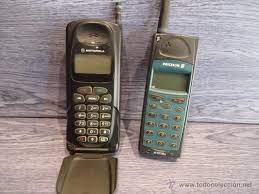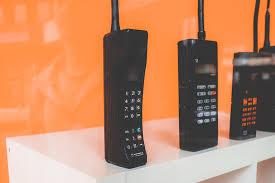History of Mobile Networks.The world of mobile telephony is possibly the one that has changed the most in recent years of the entire technological spectrum that surrounds us. But these changes have also been contributed by the different evolutions that we have experienced in connection with networks for this type of device. Going from getting the Internet into our hands and little else, until getting immediacy is the most important thing.

It is undoubted that knowing the different types of mobile networks that we have at our disposal, provided us with arguments to know if what we have with our operator is what we have agreed to or if, on the contrary, we do not have the necessary standards to consider that we are well served by Our company.
History of Mobile Networks
It all started in the 70s with really big and not very easy to transport mobiles with which you could only talk. Although now it seems somewhat minor, when it was possible to incorporate SMS messages to the terminals, 2G mobile networks provided us with a new form of communication, which in the long run was decisive for the future.
But the first great revolution arose with the arrival of the first network that helped us to have perfectly functional Internet on our phones, such as 3G , to later give way to 4G and its “dizzying” speeds at that time. Now we have to live the era of the revolution that 5G means , something that gives us the feeling that we are in the future, but living in the present. And yes, the 6G already “shows its nose”, to completely dethrone what we have known so far, but that is the future.
Birth: 1G
The first generation, or what many call 1G, only used analog channels and was only capable of broadcasting voice , with a very limited communication system, so it was normal not to have coverage in large areas. It is an absolutely obsolete technology today that was created in the 70s.
As with other types of mobile networks, the standards are practically the same throughout the world, in the case of 1G this was not the case, caused by being the first technology of this type. In Spain it was TMA , but, for example, in France it was Radiocomm 200, in Italy RTMI or in the United Kingdom TACS, there being countries like Japan that had up to three different ones such as TZ-801, TZ-802, TZ-803.
The principle of what we know: GPRS or 2G
This is the slowest technology we currently have on mobile networks. General Packet Radio Service (GPRS) was created in the 80s. It is a system that is based on frequency divisions over duplex and TDMA, being compatible with the application protocols WAP, SMS and MMS, access to the network and e-mail, and even P2P services, although their slow speed weighs on the experience.
The data transfer rate varies from 56 kbps to 114 kbps , extremely low speeds for these times and that make any type of Internet access difficult in any situation.
EDGE or EGPRS
EDGE ( Enhanced Data Rates for GSM Evolution ) or EGPRS ( Enhanced GPRS ) is a clear evolution of the GPRS system. It is an update that was extremely important at the time, since it allows us to perform the same tasks as GPRS, but with greater fluidity, since its speed reached up to 384 Kbps .
Heavy SMS could already be received, since they could be opened with a certain speed. This technology is still present today and if you look at your mobile, you can interpret it, since when an E appears above the coverage, it is indicative that you have the EDGE connection active. It is the forerunner of the first major change in mobile networks, as it paved the way for 3G quality.
Speed was important: 3G
3G was born in 2001 and was the first big step forward in terms of mobile network speed. Another more technical name for this type of connection is UMTS (Universal Mobile Telecommunication System). It is based on W-CDMA technology, whose most interesting capacity compared to what existed up to that moment is that each user transmitted at the same time as the others through the channel, encoding their signal with a different code.
The data transfer is not only faster, but it is more reliable, so it can encompass many more tasks, being able to include multimedia files , which with previous connections was unthinkable. The speeds achieved with 3G go up to 2 Mbps, which at the time of its launch meant a huge leap forward in this type of connection.
More speed: 3G +
3G + is an evolution of what 3G offered us, which is identified today on our smartphone because an H appears in the coverage. In this case it is based on the HSPDA (High Speed Downlink Packet Access) standard. The speeds it manages to reach are between 7.2 and 14.4 Mbps , so at the time it was a change that everyone appreciated.
This system had, let’s say, “two turns of the screw”, since there were two other standards such as HSUPA (High-Speed Uplink Packet Access) and HSPA + (Evolved HSPA) . With the latter, speeds of up to 84 Mbps downstream and 22 Mbps upstream are achieved . The great advantage that this evolution caused was that at last there was a sufficiently powerful connection when it came to uploading files.
The first great revolution: 4G
4G technology, born in the 2010s, was a revolution, not only because the connection speed multiplied by a lot, but because it began to mean a change in people’s mentality . With that connection, you could already watch a movie on your mobile without problems or you could upload a file to the cloud without having to wait a lot of minutes, so the way of understanding mobile devices completely changed.
Today it is the most widespread high-speed connection in our country. It is also known as LTE (Long Term Evolution) and is based on the 3GPP standard. In theory, the speeds between which this connection moves are up to 150 Mbps downstream and 50 Mbps upstream.
The future is here: 5G
The macroevolution that 5G promises for our lives is truly impressive. In Spain, there are already enough areas that have this new wireless network technology, but the truth is that its final implementation will still take time, since the truly real 5G is still on the way.
There are two types of 5G technology, the NSA (Non Standalone) and the SA (Standalone) . The first of them (NSA) does not allow to operate autonomously in 5G networks, so it needs the support of the current 4G infrastructures. That is, the communication between our device and the antenna is done with the new standard, but the communication between antennas is done with 4G, so we can never have the real speeds of 5G. With NSA technology, up to 2 Gbps downstream and up to 150 Mbps upstream are achieved .
The Standalone (SA) standard is the one that has the ability to operate autonomously and, therefore, is the one that we can speak of as the real 5G. The latency is only one millisecond, something extraordinary, achieving speeds of up to 20 Gbps .
It is clear that all this will end up reaching the entire Spanish territory and by the time that happens, technology such as GPRS or UMTS will seem absolutely obsolete, if they no longer seem so right now.
Science fiction: 6G
It is expected that we can get to know this new connection system around the year 2030 and it will bring us news that, today and without having 5G installed yet, sounds like science fiction:
- The speeds that we will talk about will already be measured in Terabytes .
- It is assumed that its coverage will be much greater than what we know right now and that it would be the first wireless connection system present in all parts of the world .
- The consumption relative to 5G will be much smaller so it will be positive for many areas of life.
- The latency much lower than 5G can ever be, which means that we will know limits that are now unsuspected.
- It will be key to the robotic revolution .
